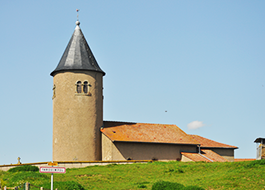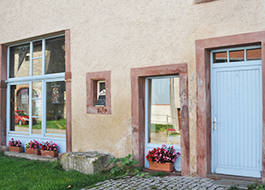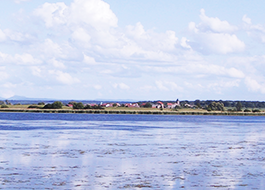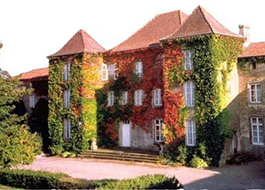Tarquimpol
Durée visite : 105 minutes
Moyen : Pédestre
Nommé Decempagi lors de la période gallo-romaine, le village était situé sur la voie romaine de Metz à Strasbourg. Il possédait un temple et un théâtre pouvant accueillir environ 10 000 personnes, ce qui en faisait un des plus grands de tout l’Est de la Gaule. La commune fut le lieu d’une grande bataille en juillet 356. Les Alamans attaquent par surprise Julien le futur empereur romain. Ils seront repoussés hors de Gaule en 357. La cité est démolie au Ve siècle. Lorsque la population gallo-romaine de Decempagi eut disparu, les Germains vinrent s’établir à sa place . Ils profitèrent des matériaux de la ville antique pour bâtir, dans l’enceinte de sa forteresse, un village qu’ils appelèrent Teichenphul. La seigneurie passe à la Lorraine en 1418. C’est une ancienne commune du département de la Meurthe. Annexée au Bezirk-Lothringen par le traité de Francfort, elle prend le nom allemand de Taichenphul. Après la Première Guerre mondiale, elle fut intégrée au département de la Moselle lorsqu’elle redevint française.
Named Decempagi during the Gallo-Roman period, the village was located on the Roman road from Metz to Strasbourg. It had a temple and a theater that could accommodate around 10,000 people, making it one of the largest in all of eastern Gaul. The town was the site of a great battle in July 356. The Alamans surprisingly attacked Julien the future Roman emperor. They will be pushed out of Gaul in 357. The city is demolished in the 5th century. When the Gallo-Roman population of Decempagi had disappeared, the Germans came to settle in its place. They took advantage of the materials of the ancient city to build, within the walls of its fortress, a village which they called Teichenphul. The seigneury passed to Lorraine in 1418. It is a former commune in the Meurthe department. Annexed to the Bezirk-Lothringen by the Treaty of Frankfurt, it takes the German name of Taichenphul. After the First World War, it was integrated into the Moselle department when it again became French.
Das Dorf wurde während der gallo-römischen Zeit Decempagi genannt und lag an der Römerstraße von Metz nach Straßburg. Es hatte einen Tempel und ein Theater, in dem rund 10.000 Menschen Platz fanden, was es zu einem der größten in ganz Ostgallien machte. Die Stadt war im Juli 356 Schauplatz einer großen Schlacht. Die Alamanen griffen überraschenderweise Julien, den zukünftigen römischen Kaiser, an. Sie werden 357 aus Gallien vertrieben. Die Stadt wird im 5. Jahrhundert abgerissen. Als die gallorömische Bevölkerung von Decempagi verschwunden war, ließen sich die Deutschen an ihrer Stelle nieder. Sie nutzten die Materialien der antiken Stadt, um innerhalb der Mauern ihrer Festung ein Dorf zu bauen, das sie Teichenphul nannten. Das Seigneury ging 1418 an Lothringen über. Es ist eine ehemalige Gemeinde im Departement Meurthe. Durch den Frankfurter Vertrag dem Bezirk Lothringen angegliedert, trägt es den deutschen Namen Taichenphul. Nach dem Ersten Weltkrieg wurde es in die Moselabteilung integriert, als es wieder französisch wurde.

D’azur au chapiteau romain d’or, sommé d’un chef du même et soutenu d’une champagne marinée d’argent.
Les ondes symbolisent l’étang de Lindre, au bord duquel se trouve Tarquimpol. La villa et la route gallo-romaines sont rappelées par le chef d’or et le chapiteau.
Azure with a Roman capital Or, topped by a head of the same and supported by a marinated champagne of silver.
The waves symbolize the Lindre pond, on the edge of which Tarquimpol is located. The villa and the Gallo-Roman road are recalled by the gold chief and the capital.
Azurblau mit einer römischen Hauptstadt Oder, gekrönt von einem Kopf desselben und unterstützt von einem marinierten Champagner aus Silber.
Die Wellen symbolisieren den Lindre-Teich, an dessen Rand sich Tarquimpol befindet. Die Villa und die gallo-römische Straße werden vom Goldchef und der Hauptstadt zurückgerufen.

Les pètroyâds = ceux qui pataugent.
Le texte du Cahier de Doléances du 15 mars 1789 nous éclaire bien sur la situation de ce village et aussi sur les circonstances qui ont fait naître le sobriquet au moment de la Révolution.
Tarquimpol est un village situé sur une petite éminence au milieu de l’Etang de Lindre. La commune est très incommodée par les eaux qui dévastent les récoltes, diminuent le terrain par alluvion, ôtent la pâture du bétail. Le seuil du marnage est beaucoup trop haut. L’étang se remplit tous les jours de limon. Les fermiers de l’étang ne donnent pas assez d’écoulement à l’eau. Les habitants pour entrer et sortir sont souvent obligés de passer à la nage. Toutes ces causes provoquent la pauvreté du lieu. Il est donc certain que les crues provoquées par l’Etang de Lindre sont à l’origine de ce surnom.
Réf. Liste de M. E. C. – Zéliqzon, Dictionnaire, p. 507
Les pètroyâds = those who flounder.
The text of the Cahier de Doléances of March 15, 1789 sheds light on the situation of this village and also on the circumstances which gave rise to the nickname at the time of the Revolution.
Tarquimpol is a village located on a small hill in the middle of the Etang de Lindre. The town is very inconvenienced by the waters which devastate the crops, reduce the land by alluvium, remove the pasture of the cattle. The threshold of the tidal range is much too high. The pond is filled with silt every day. The farmers in the pond are not giving enough water to run off. In order to get in and out, locals often have to swim. All these causes cause the poverty of the place. It is therefore certain that the floods caused by the Etang de Lindre are the origin of this nickname.
Ref. List of M. E. C. – Zéliqzon, Dictionary, p. 507
Les pètroyâds = diejenigen, die zappeln.
Der Text des Cahier de Doléances vom 15. März 1789 beleuchtet die Lage dieses Dorfes und auch die Umstände, unter denen der Spitzname zur Zeit der Revolution entstand.
Tarquimpol ist ein Dorf auf einem kleinen Hügel mitten im Etang de Lindre. Die Stadt ist sehr belästigt von den Gewässern, die die Ernte zerstören, das Land durch Schwemmland reduzieren und die Weide des Viehs entfernen. Die Schwelle des Gezeitenbereichs ist viel zu hoch. Der Teich ist jeden Tag mit Schlick gefüllt. Die Bauern im Teich geben nicht genug Wasser, um abzulaufen. Um ein- und auszusteigen, müssen die Einheimischen oft schwimmen. All diese Ursachen verursachen die Armut des Ortes. Es ist daher sicher, dass die durch den Etang de Lindre verursachten Überschwemmungen der Ursprung dieses Spitznamens sind.
Ref. Liste von M. E. C. – Zéliqzon, Dictionary, p. 507

Ferme d’Alteville
vente directe de produits fermiers
57260 TARQUIMPOL Tél : 03 87 05 46 63
Alteville Farm
direct sale of farm products
57260 TARQUIMPOL Phone: 03 87 05 46 63
Alteville Farm
Direktverkauf von landwirtschaftlichen Produkten
57260 TARQUIMPOL Telefon: 03 87 05 46 63
Les points de visites
.
Cet édifice singulier a conservé son chœur gothique du XIVe siècle et une tour romane ronde. Son mobilier, quant à lui, date du XVIIIe siècle. L’église dispose de vitraux qui ont été donnés à la paroisse par la famille de Guaita, propriétaire du château d’Alteville, vers 1880. L’un représente saint Stanislas, l’autre en face saint Antoine, des prénoms des deux fils de la famille et dont les visages les représentent. Pris dans la maçonnerie de l’église, deux éléments de stèles funéraires proviennent du site antique.
This unique building has retained its 14th century Gothic choir and a round Romanesque tower. Its furniture dates from the 18th century. The church has stained glass windows which were donated to the parish by the family of Guaita, owner of the castle of Alteville, around 1880. One represents Saint Stanislas, the other opposite Saint Antoine, of the first names of the two sons of family and whose faces represent them. Taken in the masonry of the church, two elements of funerary stelae come from the ancient site.
Dieses einzigartige Gebäude hat seinen gotischen Chor aus dem 14. Jahrhundert und einen runden romanischen Turm erhalten. Die Möbel stammen aus dem 18. Jahrhundert. Die Kirche hat Buntglasfenster, die der Familie von Guaita, dem Besitzer des Schlosses von Alteville, um 1880 der Gemeinde gestiftet wurden. Eines repräsentiert den Heiligen Stanislas, das andere gegenüber dem Heiligen Antoine mit den Vornamen der beiden Söhne von Familie und deren Gesichter repräsentieren sie. Im Mauerwerk der Kirche stammen zwei Elemente von Grabstelen aus der antiken Stätte.
.
.
Maurice Chenel est né à Tarquimpol en 1916. Saint-Cyrien, affecté en 1939 au 1er REI, puis 5ème REI au Tonkin. sous-lieutenant, il s’illustre dans les terribles combats contre les Japonais en 1945. Capitaine au Cambodge, il sert pendant la guerre d’Indochine à la tête des commandos thaïs. Fait prisonnier après Dien Ben Phu, il retrouve le 5ème REI en 1956 comme commandant. Lieutenant-colonel commandant le Groupement de la Légion Etrangère en 1959, puis chef de corps du 2ème REP en 1962, ensuite du 1er REI en 1966. Il quitte la Légion en 1968, mais continue à s’occuper de ses œuvres sociales. Il termine général de brigade. Il devient Commandeur de la Légion d’Honneur, Grand Officier de l’Ordre national du Mérite, Croix de guerre 1939-45, Croix de guerre des Théâtres d’Opérations Extérieurs, Croix de la Valeur militaire, 8 citations. Le général Chenel est mort en 1996.
Maurice Chenel was born in Tarquimpol in 1916. Saint-Cyrien, assigned in 1939 to the 1st REI, then 5th REI in Tonkin. Second lieutenant, he distinguished himself in the terrible battles against the Japanese in 1945. Captain in Cambodia, he served during the Indochina War at the head of the Thai commandos. Taken prisoner after Dien Ben Phu, he found the 5th REI in 1956 as commander. Lieutenant-colonel commanding the Groupement de la Légion Etrangère in 1959, then corps commander of the 2nd REP in 1962, then of the 1er REI in 1966. He left the Legion in 1968, but continued to take care of his social works. He finishes brigadier general. He became Commander of the Legion of Honor, Grand Officer of the National Order of Merit, Croix de guerre 1939-45, Croix de guerre of Foreign Operations Theaters, Cross of Military Valor, 8 citations. General Chenel died in 1996.
Maurice Chenel wurde 1916 in Tarquimpol geboren. Saint-Cyrien, 1939 dem 1. REI, dann dem 5. REI in Tonkin zugeordnet. Zweiter Leutnant, er zeichnete sich 1945 in den schrecklichen Kämpfen gegen die Japaner aus. Als Kapitän in Kambodscha diente er während des Indochina-Krieges an der Spitze der thailändischen Kommandos. Nach Dien Ben Phu gefangen genommen, fand er 1956 die 5. REI als Kommandeur. Oberstleutnant, der 1959 das Groupement de la Légion Etrangère befehligte, 1962 Korps-Kommandeur der 2. REP, 1966, dann der 1er REI. Er verließ die Legion 1968, kümmerte sich aber weiterhin um seine Sozialarbeit. Er beendet Brigadegeneral. Er wurde Kommandeur der Ehrenlegion, Großoffizier des Nationalen Verdienstordens, Croix de Guerre 1939-45, Croix de Guerre der Theater für ausländische Operationen, Kreuz der militärischen Tapferkeit, 8 Zitate. General Chenel starb 1996.
.
Située sur le territoire du Parc naturel régional de Lorraine, au cœur de l’étang de Lindre, l’Association pour l’animation de la Maison du Pays des Étangs s’investit, depuis sa création en 1996, dans le développement local à travers des actions en faveur de l’environnement, du patrimoine naturel et historique. L’association agit pour une meilleure prise en compte de l’environnement. L’éducation à l’environnement, la découverte du patrimoine historique de Tarquimpol, des formations pour les professionnels et pour tous publics, telles sont les thèmes développés par cette association.
Located on the territory of the Lorraine Regional Natural Park, in the heart of the Lindre pond, the Association for the animation of the Maison du Pays des Étangs has been involved, since its creation in 1996, in local development through actions in favor of the environment, natural and historical heritage. The association acts to take better account of the environment. Environmental education, discovery of the historical heritage of Tarquimpol, training courses for professionals and for all audiences, these are the themes developed by this association.
Der Verein für die Animation des Maison du Pays des Étangs befindet sich auf dem Gebiet des regionalen Naturparks Lothringen im Herzen des Lindre-Teichs und ist seit seiner Gründung im Jahr 1996 an der lokalen Entwicklung beteiligt Maßnahmen zugunsten der Umwelt, des natürlichen und historischen Erbes. Der Verein handelt, um die Umwelt besser zu berücksichtigen. Umwelterziehung, Entdeckung des historischen Erbes von Tarquimpol, Schulungen für Fachleute und für alle Zielgruppen sind die von diesem Verband entwickelten Themen.
MAISON DU PAYS DES ÉTANGS
3 Rue Georges Berger 57260 TARQUIMPOL
Tél : 06 71 42 15 47 sur rendez-vous
.
Pendant la guerre de Trente ans, les Suédois semaient la terreur et la ruine en Lorraine. Ils offrirent à leur chef, Eric-le-Sanglant, blessé à mort, une sépulture digne de sa valeur. Revêtu de son armure, son épée au côté, ses bijoux étalés sur la poitrine, ils le placèrent sur son cheval et immergèrent maître et monture dans les profondeurs de l’étang. Ensuite, ils enfouirent son trésor de guerre dans une fosse creusée à proximité. Depuis cette époque lointaine, chaque année, au moment de l’équinoxe d’automne, lorsque sonnent les douze coups de minuit, le cavalier et sa monture remontent du fond des eaux, risquent quelques pas sur le rivage, puis regagnent leur demeure liquide.
Un jour, un jeune homme de Tarquimpol tenta de s’emparer de ce trésor aux douze coups de minuit. Il saisit le cheval par la bride mais fut emporté par lui dans les eaux de l’étang. Quelques jours plus tard, on retrouva sa coiffe. Son corps, quant à lui, est resté prisonnier de l’étang.
During the Thirty Years War, the Swedes sowed terror and ruin in Lorraine. They offered their leader, Eric-le-Sanglant, wounded to death, a burial worthy of his value. Clad in his armor, his sword by his side, his jewels spread out on his chest, they placed him on his horse and immersed master and mount in the depths of the pond. Then they buried his war chest in a pit dug nearby. Since that distant time, each year, at the time of the autumn equinox, when the stroke of midnight strikes, the rider and his mount ascend from the bottom of the water, risk a few steps on the shore, then return to their liquid home.
One day, a young man from Tarquimpol tried to seize this treasure at the stroke of midnight. He grabbed the horse by the bridle but was carried by him into the waters of the pond. A few days later, her headdress was found. His body, meanwhile, remained trapped in the pond.
Während des Dreißigjährigen Krieges säten die Schweden in Lothringen Terror und Ruine. Sie boten ihrem zu Tode verwundeten Anführer Eric-le-Sanglant eine Beerdigung an, die seines Wertes würdig war. In seine Rüstung gekleidet, sein Schwert an seiner Seite, seine Juwelen auf seiner Brust ausgebreitet, legten sie ihn auf sein Pferd und tauchten Meister und Berg in die Tiefen des Teiches. Dann begruben sie seine Kriegskasse in einer nahe gelegenen Grube. Seit dieser fernen Zeit riskieren der Reiter und sein Reittier jedes Jahr zur Zeit des Herbst-Äquinoktiums, wenn der Mitternachtsschlag zuschlägt, ein paar Schritte am Ufer und kehren dann in ihre flüssige Heimat zurück.
Eines Tages versuchte ein junger Mann aus Tarquimpol um Mitternacht, diesen Schatz zu beschlagnahmen. Er packte das Pferd am Zaumzeug, wurde aber von ihm ins Wasser des Teiches getragen. Einige Tage später wurde sein Kopfschmuck gefunden. Sein Körper blieb unterdessen im Teich gefangen.
.
Le château est constitué de deux bâtisses en vis-à-vis. La première est édifiée par Étienne Toupet, en 1564, quand il obtient le fief d’Alteville du duc Charles IV de Lorraine. C’est une maison forte typique avec une tourelle, des meurtrières et des fenêtres à meneaux. La seconde, construite en 1698 par Charles Palléot est un pavillon carré de deux étages flanqué de deux ailes. En 1786, ce château était la propriété de Nicolas Leclerc, l’un des fermiers généraux des domaines de Lorraine et du Barrois. En 1819, le général Charles Louis Dieudonné Grandjean hérite du domaine. En 1851, Amélie Marie Grandjean épouse François Paul Guaita , le père de Stanislas de Guaita qui naîtra dans le château familial. Il est occultiste et poète. Il fonde avec Péladan l’Ordre kabbalistique de la Rose-Croix. La famille Barthélémy s’y installe en 1906. Le domaine d’Alteville est fortement endommagé, durant la Seconde Guerre mondiale, par des troupes allemandes qui détruisent la chapelle. Il a depuis été restauré. Le bâtiment est aménagé à l’heure actuelle en chambres d’hôtes.
The castle consists of two buildings facing each other. The first was built by Étienne Toupet in 1564, when he obtained the fiefdom of Alteville from Duke Charles IV of Lorraine. It is a typical fortified house with a turret, loopholes and mullioned windows. The second, built in 1698 by Charles Palléot, is a square two-storey pavilion flanked by two wings. In 1786, this castle was the property of Nicolas Leclerc, one of the farmers general of the domains of Lorraine and Barrois. In 1819, General Charles Louis Dieudonné Grandjean inherited the estate. In 1851, Amélie Marie Grandjean married François Paul Guaita, the father of Stanislas de Guaita who was born in the family castle. He is an occultist and a poet. He founded with Peladan the Kabbalistic Order of the Rose-Croix. The Barthélémy family moved there in 1906. The Alteville estate was heavily damaged during World War II by German troops who destroyed the chapel. It has since been restored. The building is currently converted into guest rooms.
Das Schloss besteht aus zwei einander zugewandten Gebäuden. Der erste wurde 1564 von Étienne Toupet erbaut, als er von Herzog Karl IV. Von Lothringen das Lehen von Alteville erhielt. Es ist ein typisches befestigtes Haus mit einem Turm, Schlupflöchern und zweiflügeligen Fenstern. Der zweite, 1698 von Charles Palléot erbaute Pavillon ist ein quadratischer zweistöckiger Pavillon, der von zwei Flügeln flankiert wird. 1786 war diese Burg Eigentum von Nicolas Leclerc, einem der Generalbauern der Gebiete Lothringen und Barrois. Im Jahr 1819 erbte General Charles Louis Dieudonné Grandjean das Anwesen. Amélie Marie Grandjean heiratete 1851 François Paul Guaita, den Vater von Stanislas de Guaita, der im Familienschloss geboren wurde. Er ist Okkultist und Dichter. Er gründete mit Peladan den Kabbalistischen Orden der Rose-Croix. Die Familie Barthélémy zog 1906 dorthin. Das Anwesen in Alteville wurde im Zweiten Weltkrieg von deutschen Truppen, die die Kapelle zerstörten, schwer beschädigt. Es wurde inzwischen restauriert. Das Gebäude wird derzeit in Gästezimmer umgewandelt.










